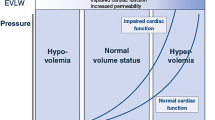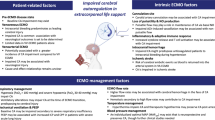Summary
The influence of anaesthetic agents and propranolol pretreatment on the adequacy of cardiovascular adjustment to progressive normovolaemic hemodilution and to the combination of anaemia and blood loss was studied in a total of 18 dogs which were divided into 3 groups of 6 dogs each. One group received neuroleptanalgesia, the second group was anaesthetized with halothane (1%), group three received halothane (1%) and was pretreated with propranolol (0.5 mg/kg). Acute isovolaemic anaemia was produced by a stepwise exchange of blood with 6% dextran. The total exchange volume was 70 ml/kg which was associated with a decrease of mean hematocrit values from about 45% to 16%. Cardiac output rose continuously with progressive hemodilution, the maximum percentage increases were 39% in the neuroleptanalgesia-group, 59% in the halothane-group and in the animals with halothane anaesthesia and propranolol pretreatment. These changes were due to increases in both heart rate and stroke volume, the greatest percent rise in stroke index (36%) and the least change in heart rate (+18%) being observed in the propranolol-treated dogs. Apart from a small overshoot of the systemic oxygen availability during the initial stages of exchange transfusion in the neuroleptanalgesia- and halothane-group, the reduced arterial oxygen content was not compensated by the increase in cardiac output. Consequently, there was a continuous reduction of the systemic oxygen transport capacity with a maximum decrease of about 40% in either group. Systemic oxygen uptake was maintained over a wide range of hematocrits by an increased extraction of oxygen from blood. Mean arterial pressure essentially remained unaffected in each of the groups, the changes in total peripheral resistance were inverse to that of cardiac output and showed little differences between the three groups in response to exchange transfusions. Left ventricular dP/dt values, left ventricular volumes and ejection fractions indicated an improved ventricular performance and a participation of the Frank-Starling mechanism in the response of the heart to isovolaemic hemodilution. The combination of hemodilution and limited blood loss (15 ml/kg) led to a significant reduction in arterial pressure and cardiac output, but all dogs tolerated this amount of hemorrhage and there was no indication of critical impairment of cardiac performance in any of the 3 groups. No major changes of the acid-base status were observed throughout the study. Thus, the adjustment of the normal cardiovascular system to acute normo- and hypovolaemic hemodilution appeared to be largely independent of the type of anaesthesia and of the presence or absence of betareceptor blockade.
Similar content being viewed by others
References
Bretschneider, H. J., J. Martel, G. Hellige, I. Hensel, D. Kettler: Verh. Dtsch. Ges. Kreislaufforschg.38, 233 (1972).
Chamorro, G., J. A. Rodriguez, B. Dzindzio, E. Rapaport: Circulat. Res.32, 530 (1973).
Escobar, E., N. L. Jones, E. Rapaport, J. F. Murray: Am. J. Physiol.211, 877 (1966)
Fowler, N. O., J. C. Holmes: J. Appl. Physiol.39, 453 (1975).
Geha, A. S.: Surgery80, 47 (1976).
Kettler, D., K. Hellberg, G. Klaess, J. S. Kontokollias, R. de Vivie: Anaesthesist25, 131 (1976).
Messmer, K., L. Sunder-Plassmann, W. P. Klövekorn, K. Holper: Advanc. Microcirculat.4, 1 (1972).
Messmer, K.: Surg. Clin. North Am.55, 659 (1975).
Murray, J. F., E. Rapaport: Cardiovasc. Res.6, 360 (1972).
Pavek, K., J. S. Carey: Am. J. Physiol.226, 1172 (1974).
v. Restorff, W., B. Höfling, J. Holtz, E. Bassenge: Pflügers Arch.357, 25 (1975).
Rodriguez, J. A., G. A. Chamorro, E. Rapaport: J. Appl. Physiol.36, 28 (1974).
Slama, H., J. Piiper: Z. Kreislaufforschg.53, 322 (1964).
Carey, J. S.: J. Thorac. Cardiovasc. Surg.62, 103 (1971).
Author information
Authors and Affiliations
Additional information
With 8 figures and 1 table
Rights and permissions
About this article
Cite this article
Tarnow, J., Eberlein, H.J., Hess, W. et al. Hemodynamic interactions of hemodilution, anaesthesia, propranolol pretreatment and hypovolaemia I. Systemic circulation. Basic Res Cardiol 74, 109–122 (1979). https://doi.org/10.1007/BF01907814
Received:
Issue Date:
DOI: https://doi.org/10.1007/BF01907814




